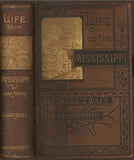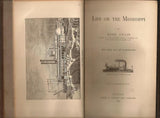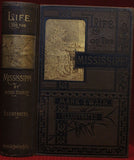Life on the Mississippi
Author: Twain, Mark [PSUED Samuel Langhorne Clemens] (1835-1910)
Year: 1883
Publisher: James R Osgood and Company
Place: Boston
Description:
624 pages with frontispiece and over 300 black and white illustrations. Royal Octavo (9" x 6 1/4") Issued in the original brown cloth with gilt lettering and pictorial on spine and black and gilt lettering with pictorial on cover. Lacks the illustration of Twain's head in flames on page 441, and the corrected "St Charles Hotel" on page 443. Simultaneously published in 1883 in the United States and Great Britain, the book is the first submitted to a publisher as a typewritten manuscript (BAL 34II) Second state of the first American edition.
Twain once remarked that he considered this book his masterpiece, the book that would outlive his other works and endure as a classic. Of course, Twain once defined a classic as a book everybody talks about but nobody ever reads. At first glance it seems to be a travel book, but it is really a highly readable discursive autobiographical account of Twain's boyhood and his region, and of a culture that radically changed since he left home 30 years earlier. It makes good reading as background for Huck Finn. The only thing that is known of the printing history is what Twain wrote in 1891: that 50,000 copies were printed and bound, but only 32,000 sold. Implication is that the unsold copies were reissued by Charles L Webster between 1884 and 1891 when he took over Osgood's stock. Copies are found with Osgood's sheets and Webster cancel title-page, in Webster bindings, dated 1888 and 1891. As a subscription book, this book was similar in size to the hefty tomes of the American Publishing Company, but the handsome pictorial brown cloth binding ranks with the binding of Huck Finn as one of the best on a Twain first edition. It could be ordered with gilt edges, in full sheep, three-quarter morocco, and three-quarter calf. (MacDonald: Firsts.)
This is a memoir by Mark Twain of his days as a steamboat pilot on the Mississippi River before the American Civil War, and also a travel book, recounting his trip along the Mississippi River from St. Louis to New Orleans many years after the War. The book begins with a brief history of the river as reported by Europeans and Americans, beginning with the Spanish explorer Hernando de Soto in 1542. It continues with anecdotes of Twain's training as a steamboat pilot, as the 'cub' (apprentice) of an experienced pilot, Horace E. Bixby. He describes, with great affection, the science of navigating the ever-changing Mississippi River in a section that was first published in 1876, entitled "Old Times on the Mississippi". Although Twain was actually 21 when he began his training, he uses artistic license to make himself seem somewhat younger, referring to himself as a "fledgling" and a "boy" who "ran away from home" to seek his fortune on the river, and playing up his own callowness and naïveté.In the second half, Twain narrates his trip many years later on a steamboat from St. Louis to New Orleans. He describes the competition from railroads, and the new, large cities, and adds his observations on greed, gullibility, tragedy, and bad architecture. He also tells some stories that are most likely tall tales. In 1980 the book was adapted as a TV movie for American public television, with David Knell performing as Sam Clemens, and Robert Lansing as Horace Bixby, the steamboat pilot who mentored him. The film used many tall tales from the book, woven into a fictional narrative. In 2010, Life on the Mississippi was adapted as a stage musical, with book and lyrics by Douglas M. Parker and music by Denver Casado. It was produced that year in Kansas City, Missouri and Door County, Wisconsin.
Condition:
Recased in original spine, some occasional foxing and finger soiling, one signature slightly sprung else a very good and bright copy.
Year: 1883
Publisher: James R Osgood and Company
Place: Boston
Description:
624 pages with frontispiece and over 300 black and white illustrations. Royal Octavo (9" x 6 1/4") Issued in the original brown cloth with gilt lettering and pictorial on spine and black and gilt lettering with pictorial on cover. Lacks the illustration of Twain's head in flames on page 441, and the corrected "St Charles Hotel" on page 443. Simultaneously published in 1883 in the United States and Great Britain, the book is the first submitted to a publisher as a typewritten manuscript (BAL 34II) Second state of the first American edition.
Twain once remarked that he considered this book his masterpiece, the book that would outlive his other works and endure as a classic. Of course, Twain once defined a classic as a book everybody talks about but nobody ever reads. At first glance it seems to be a travel book, but it is really a highly readable discursive autobiographical account of Twain's boyhood and his region, and of a culture that radically changed since he left home 30 years earlier. It makes good reading as background for Huck Finn. The only thing that is known of the printing history is what Twain wrote in 1891: that 50,000 copies were printed and bound, but only 32,000 sold. Implication is that the unsold copies were reissued by Charles L Webster between 1884 and 1891 when he took over Osgood's stock. Copies are found with Osgood's sheets and Webster cancel title-page, in Webster bindings, dated 1888 and 1891. As a subscription book, this book was similar in size to the hefty tomes of the American Publishing Company, but the handsome pictorial brown cloth binding ranks with the binding of Huck Finn as one of the best on a Twain first edition. It could be ordered with gilt edges, in full sheep, three-quarter morocco, and three-quarter calf. (MacDonald: Firsts.)
This is a memoir by Mark Twain of his days as a steamboat pilot on the Mississippi River before the American Civil War, and also a travel book, recounting his trip along the Mississippi River from St. Louis to New Orleans many years after the War. The book begins with a brief history of the river as reported by Europeans and Americans, beginning with the Spanish explorer Hernando de Soto in 1542. It continues with anecdotes of Twain's training as a steamboat pilot, as the 'cub' (apprentice) of an experienced pilot, Horace E. Bixby. He describes, with great affection, the science of navigating the ever-changing Mississippi River in a section that was first published in 1876, entitled "Old Times on the Mississippi". Although Twain was actually 21 when he began his training, he uses artistic license to make himself seem somewhat younger, referring to himself as a "fledgling" and a "boy" who "ran away from home" to seek his fortune on the river, and playing up his own callowness and naïveté.In the second half, Twain narrates his trip many years later on a steamboat from St. Louis to New Orleans. He describes the competition from railroads, and the new, large cities, and adds his observations on greed, gullibility, tragedy, and bad architecture. He also tells some stories that are most likely tall tales. In 1980 the book was adapted as a TV movie for American public television, with David Knell performing as Sam Clemens, and Robert Lansing as Horace Bixby, the steamboat pilot who mentored him. The film used many tall tales from the book, woven into a fictional narrative. In 2010, Life on the Mississippi was adapted as a stage musical, with book and lyrics by Douglas M. Parker and music by Denver Casado. It was produced that year in Kansas City, Missouri and Door County, Wisconsin.
Condition:
Recased in original spine, some occasional foxing and finger soiling, one signature slightly sprung else a very good and bright copy.













